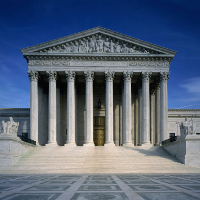 CPIP has published a new policy brief celebrating the fortieth anniversary of the Diamond v. Chakrabarty decision, where the Supreme Court in 1980 held that a genetically modified bacteria was patentable subject matter. The brief, entitled Forty Years Since Diamond v. Chakrabarty: Legal Underpinnings and its Impact on the Biotechnology Industry and Society and written by Matthew Jordan, Neil Davey, Maheshkumar P. Joshi, and Raj Davé, is dedicated to the late Dr. Ananda Chakrabarty, a pioneer in the biotechnology world, who passed away in July 2020.
CPIP has published a new policy brief celebrating the fortieth anniversary of the Diamond v. Chakrabarty decision, where the Supreme Court in 1980 held that a genetically modified bacteria was patentable subject matter. The brief, entitled Forty Years Since Diamond v. Chakrabarty: Legal Underpinnings and its Impact on the Biotechnology Industry and Society and written by Matthew Jordan, Neil Davey, Maheshkumar P. Joshi, and Raj Davé, is dedicated to the late Dr. Ananda Chakrabarty, a pioneer in the biotechnology world, who passed away in July 2020.
Chakrabarty had a great impact on the biotechnology revolution, ushering in a new era of technological advances that have benefited humankind. Through interviews with Randall Rader, former Chief Judge of the Federal Circuit, and Dr. Chakrabarty himself, as well as case studies on genetically modified seeds, polymerase chain reactions, and monoclonal antibody therapies, the policy brief explores the importance and enduring implications for society of the Chakrabarty decision.
The introduction and conclusion sections are copied below:
***
I. Introduction: The Diamond v. Chakrabarty (1980) Supreme Court Decision
In 1972, Ananda Chakrabarty—a genetic engineer at General Electric—filed a patent application for genetically modified bacteria capable of breaking down crude oil. Dr. Chakrabarty introduced genetic fragments into the Pseudomonas bacterium, altering the bacteria to decompose hydrocarbon components of crude oil. Dr. Chakrabarty intended the bacteria to assist in cleaning up oil spills. The engineered bacteria were especially suited for bioremediation given their resistance to adverse environments and safety as a non-pathogen.
The examiner rejected the application under Section 101 of the Patent Act, which covers patentable subject matter, because living things were not patentable. The Board of Patent Appeals and Interferences (now known as the Patent Trial and Appeal Board) affirmed the examiner’s decision, however, the U.S. Court of Customs and Patent Appeals (now part of the U.S. Court of Appeals for the Federal Circuit) sided with Dr. Chakrabarty. The Court of Customs, in an opinion by Judge Giles Rich, reasoned that only naturally occurring articles, not all living things, were ineligible for patenting. Importantly, the court said, “the fact that microorganisms are alive is a distinction without legal significance” for purposes of the patent law. Then, U.S. Patent and Trademark Office (USPTO) Commissioner Sidney Diamond appealed the case to the Supreme Court.
The Supreme Court of the United States held that Dr. Chakrabarty’s invention consisted of patentable subject matter. Section 101 states: “Whoever invents or discovers any new and useful process, machine, manufacture, or composition of matter, or any new and useful improvement thereof, may obtain a patent therefor, subject to the conditions and requirements of this title.” The Court ruled in a landmark 5-4 decision that Dr. Chakrabarty’s invention was a patentable, manmade, “composition of matter” or “manufacture.” Chief Justice Warren Burger famously quoted a Senate Report that was part of the legislative history for the Patent Act of 1952: patentable subject matter included “anything under the sun that is made by man.”
This decision had immense implications for biotechnology. It resulted in patents for genetically modified seeds, DNA amplification technology, and monoclonal antibody therapy. The rise of biotechnology has impacted many technological fields and society as a whole. The Supreme Court’s distinction between manmade and naturally occurring phenomena was clarified in Mayo v. Prometheus and AMP v. Myriad. The Court found that naturally occurring biological relationships and isolated DNA sequences were not eligible for patenting.
***
V. Conclusion
Diamond v. Chakrabarty revolutionized the biotechnology industry in the United States by incentivizing the advancement of inventions that are beneficial to human life. However, as noted by Judge Randall Rader: “This whole patent eligibility question—which was so clear and well-defined, was practically implementable and understandable, and gave life to our whole biotech industry after Chakrabarty—now has had a heavy cloud cast over it in recent jurisprudence such as Myriad.”
When asked if our legislature should take action to clear up the confusion, Judge Rader stated: “If the statute was the written law that was being interpreted by the Supreme Court, we wouldn’t need legislative change. But the sad truth is that the Supreme Court has created a whole overlay of doctrine that makes the statute almost irrelevant. And now we don’t look at whether there’s a process, a machine, an article of manufacture, or a composition of matter. Instead, we look at whether there’s something more beyond the conventional and the routine and the well-known. We argue over what is something and what is more, and what is an inventive concept. And so in that state of confusion, yes, we’re probably going to need legislation.”
Within the dire context of the COVID-19 pandemic and other countries racing past the United States in biotechnology, it is crucial for Congress to clarify what currently qualifies as patentable subject matter.
***
To read the policy brief, please click here.

